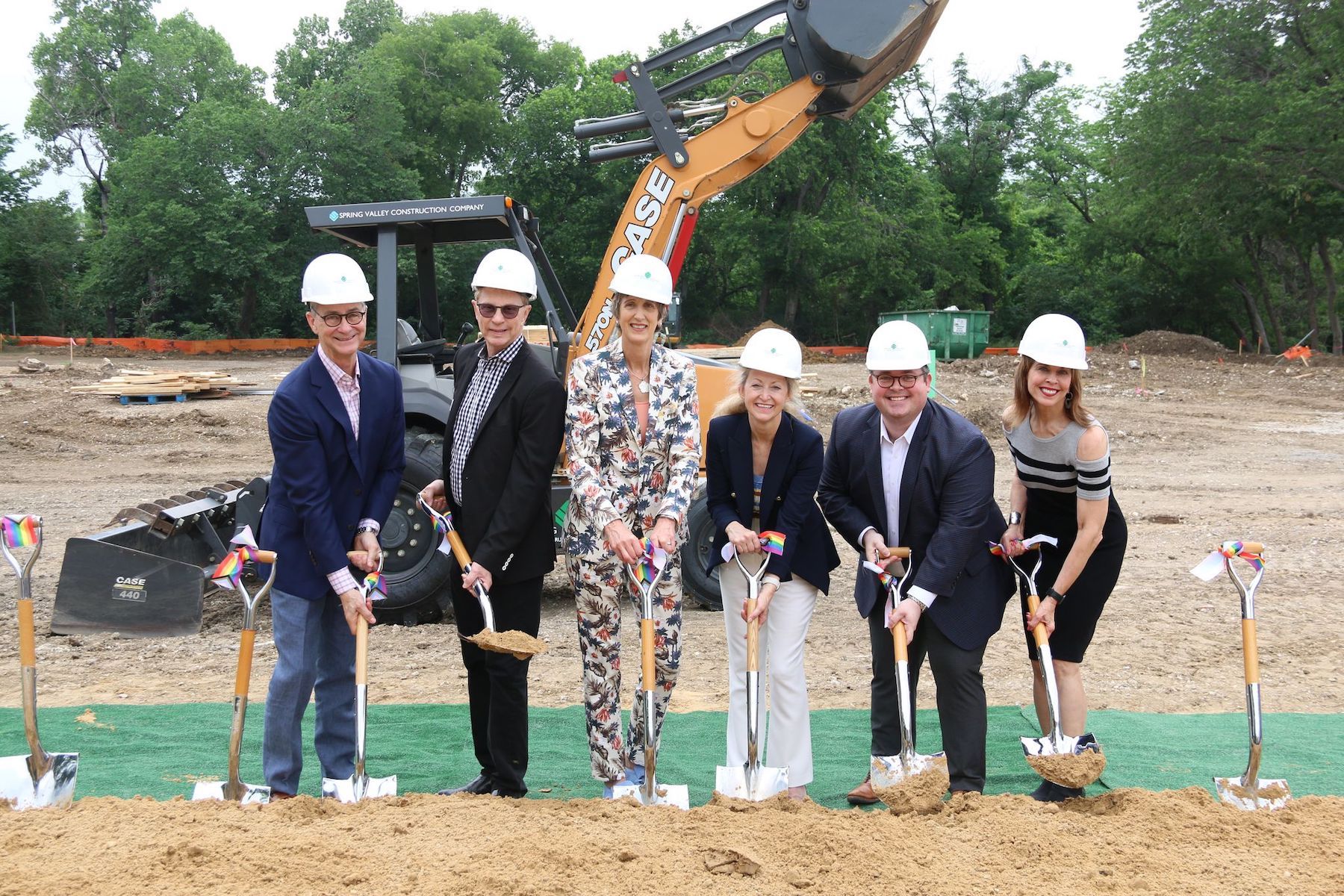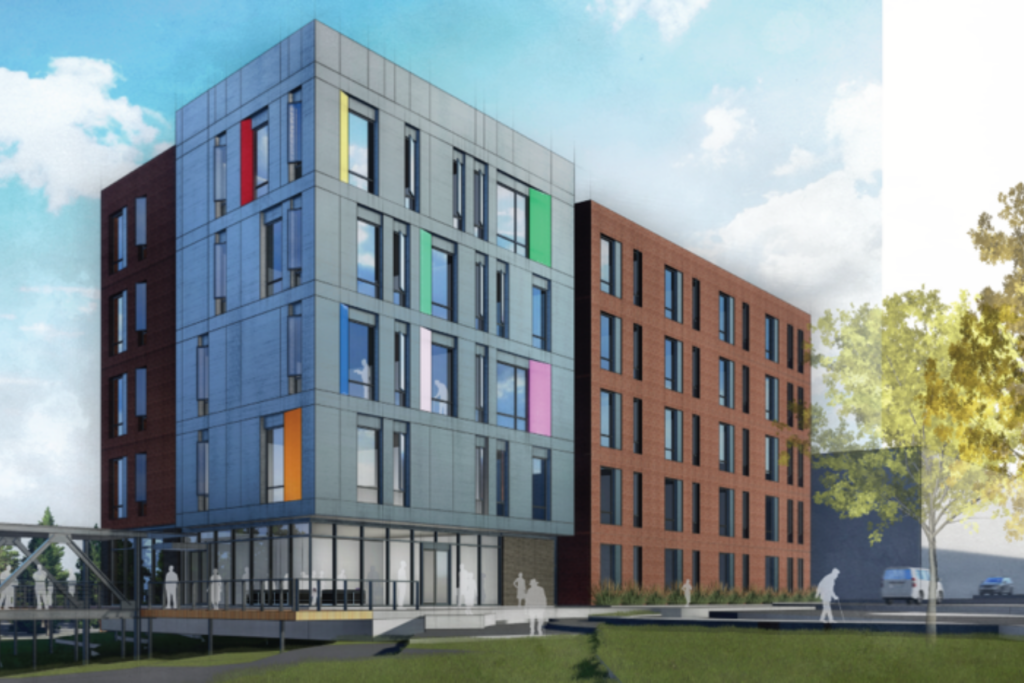On a warm Friday morning in May, hundreds of public officials, nonprofit leaders, bankers, builders, and community members gathered at an empty construction site at 5723 Sadler Cir., on the edge of Oak Lawn. The mood was mirthful as hard-hatted staff from the Resource Center dug into the dirt using shovels tied with rainbow ribbons. They were celebrating the groundbreaking of Oak Lawn Place, a Resource Center-led LGBTQ+ friendly and affordable senior living development.
“It was a really positive, joyful, coming together day,” Resource Center CEO Cece Cox says, reflecting on the May 12 event, “where I felt like everyone who was there was really grateful and happy that this is happening and saw how when a community works together, what the result can be.”
The senior living facility, which is set to open next year, will include 84 one- and two-bedroom apartments for adults aged 55 and up. Every unit is categorized as affordable housing, Cox says, with rents set at 30, 50, or 60 percent of the city’s average median income. Oak Lawn Place will also be “welcoming and affirming” to LGBTQ+ seniors through its décor, language, programs, and services.
Having a facility like this for seniors is sorely needed, Cox says. “There’s a huge need for safe, welcoming, and affordable housing in the queer aging population.”
Nearly one in three LGBTQ seniors live at or below the federal poverty level. Because gay marriage was legalized only in 2015, the queer community hasn’t had the same opportunities to accumulate wealth over their lifetimes. “Let’s say you have a couple that had been together for 30 years, one of them dies, the surviving spouse was not eligible to receive Social Security benefits,” Cox says. “And so that really impacts someone’s long-term financial status.”
Tied to that, many LGBTQ+ seniors have been cut off from their biological families. They are less likely to be married and are three-to-four times less likely to have children, according to the American Medical Association. This has left many with a far smaller network of caregivers and support. They are more likely to suffer from chronic illness and mental health issues, like disability, depression, and social isolation.
Additionally, LGBTQ+ seniors have faced a long history of housing and medical discrimination. “We oftentimes do not seek the medical care that we need,” says Cox, “because we’ve either been discriminated against in the past or we fear there will be bias or discrimination or lack of cultural competency.” Per the 19th News, 28 percent of LGBTQ+ Americans have felt stereotyped by their healthcare provider, and 16 percent have been denied medical care. LGBT seniors are more likely to face discrimination during end-of-life care, and many opt to hide their sexuality and gender identity when searching for housing and long-term care communities.
Over the years, the Resource Center, which provides health, advocacy, and educational programs to the Dallas LGBTQ+ population, has put out surveys asking folks to identify important issues to them. Those surveys found that affordable senior housing is one of the community’s biggest concerns. There are more than 13,000 aging LGBTQ seniors in North Texas, and that number is expected to double over the next decade.
Building a senior housing facility to help this issue has been on the Resource Center’s priority list since 2012, Cox says. About five or six years ago, the organization started to explore what a development like this would look like and what it would cost.
They reached out to similar organizations across the country and toured other LGBTQ+ friendly living facilities, like the John C. Anderson Cultural Center and Apartments in Philadelphia, Triangle Square in Los Angeles, and the Montrose Center in Houston. The Heartland Alliance in Chicago “is particularly inspiring,” Cox says. The community center takes up a whole block within walking distance to Wrigley Field, and its nearby senior living development has a grocery store on its ground level. “It’s just interesting how it’s laid out and in a very pedestrian-friendly place.”
Cox says they wanted to get a feel for these places, “and whether it feels like it’s working or not. And whether it feels like people are creating community.” Resource Center officials talked to staff at these developments, getting inspiration, lessons learned, and ideas for how to set up a potential Dallas facility. They didn’t want to “toss up a building that was a box,” Cox says. They wanted to create a supportive community.

By 2019, Cox says they had already spent close to $1 million researching a potential housing development. They had to make a decision, so they elected to move forward, secure funding, find a location, and build the facility.
They looked at 30 to 40 potential sites, Cox says. The property needed to be within its budget and, ideally, the planners wanted to be in Oak Lawn, which has been the heart of Dallas’ LGBTQ+ community for decades. Then, they found the site on Sadler Circle.
Cox says the location checks off all Resource Center’s boxes. “It’s absolutely ideal for us.” It’s in Oak Lawn, just off Inwood Road. It’s only a half-mile walk from their community center on Cedar Springs, where the organization puts on many of its services, like THRIVE, the seniors program. And it’s only a quarter-mile walk from the Inwood/Love Field DART station. That was an important factor in their decision, Cox says. When you’re low income, “every penny counts,” and many residents won’t have cars.
To get the land, though, was “quite a negotiation,” Cox says. “Four sellers, seven parcels of land. Simultaneous closings. Not easy to do.” They closed on all seven parcels in November 2020 for $2,950,000. The whole project, developed by Matthews Southwest and Volunteers of America, will cost $31 million, funded through things like grants and tax credits.
The planned development’s exterior space will be “really spectacular,” Cox says, with a large deck and a canopy of trees. Resource Center tapped architects at Perkins & Will and general contractor Spring Valley Construction Company to design and build the five-story building. The actual apartments will be modern and high quality, Cox says. There will be art from Ted Kincaid and Scott Anderson throughout the building. The bottom floor will feature the lobby, workout room, meeting rooms, and community spaces, where there will be related programming.
That’s what sets Oak Lawn Place apart from other apartment complexes, Cox says. “What distinguishes it from that is that there are programs and services specifically dedicated to the population and operated by Resource Center.” The organization will host a “menu of activities” that support the aging residents. For example, there will be classes and speakers on financial literacy, social security benefits, caregiving, Alzheimer’s, and more. They will host some THRIVE programs here, to help the community mix and mingle. And there will be holiday-related activities, like a Thanksgiving meal and Halloween crafts.
If all goes according to schedule, Oak Lawn Place will open summer 2024. The Resource Center already has an interest list for potential tenants.
Building any affordable housing development in Dallas is a big deal for the community, Cox says. But for the Resource Center, it is a symbol of the community’s resilience, especially as Texas lawmakers passed a slew of anti-LGBTQ bills during the 2023 legislative session. The development, she says, “is serving as a beacon of hope.”
Cox is excited to give around 100 people the opportunity to build community and to “feel safe and affirmed and seen, and have a comfortable, welcoming living environment.”
The summer 2024 opening date is especially fortuitous, too, as next year marks the 55th anniversary of the 1969 Stonewall Uprising in New York, which served as a catalyst for much of the LGBTQ+ activism over the past half century. Many of Oak Lawn Place’s future residents will be old enough to remember Stonewall, says Cox. Some may have even participated. That generation of LGBTQ+ baby boomers, called the Stonewall Generation, laid the foundation for nonprofits like the Resource Center to operate, she says. This is their opportunity to support them.
“We’ve had the blessing of building upon this foundation of our elders,” Cox says. “And now are able to contribute a safe place for them to live.”
Get the AtHome Newsletter
Author





